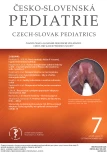Comparing creatinine-estimated and cystatin C-estimated glomerular filtration rates in children with a congenital solitary kidney
Authors:
H. Flögelová 1; J. Prošková 2; K. Langová 3; D. Dvořák 1
Authors‘ workplace:
Dětská klinika, Lékařská fakulta Univerzity Palackého v Olomouci a Fakultní nemocnice Olomouc
1; Oddělení klinické biochemie, Fakultní nemocnice Olomouc
2; Ústav lékařské biofyziky, Lékařská fakulta Univerzity Palackého v Olomouci
3
Published in:
Čes-slov Pediat 2021; 76 (7): 368-372.
Category:
Original Papers
Overview
Introduction and aim of the study: During their lives, people with a solitary kidney develop hyperfiltration damaging the kidney and results in decreased renal function. Reduced Schwartz-estimated GFR is a relatively late marker of renal damage. According to some authors, an earlier marker of subclinical damage to the solitary kidney is serum cystatin C. The study aimed to determine whether in children with a congenital solitary/solitary functioning kidney (SFK), cystatin C-estimated GFR is significantly lower than creatinine-estimated GFR.
Methods: A prospective study assessed GFRs in 70 children aged 2–18 years (mean 9.1 years; 49 boys) with a SFK due to unilateral agenesis or multicystic dysplasia. Excluded were children with SFK and additional CAKUT or a history of febrile UTI. Serum creatinine (μmol/L) was measured using the enzymatic method. Cystatin C (mg/L) was measured with an immunoturbidimetric assay. A difference was determined between GFRs estimated with the following formulae:
Schwarz-estimated GFR: height in cm x 0.6/creatinine
Cystatin C-estimated GFR: 1.178 x (Scyst)-0.931
For statistical analyses, the paired t-test, non-parametric Wilcoxon test and Bland-Altman plot were used.
Results: The mean Schwartz- and cystatin C-estimated GFRs were 1.639 (SD 0.295) and 1.268 (SD 0.196) mL/s/1.73 m2, respectively; a statistically significant difference (p<0.0001). The Bland-Altman plot suggested that the difference between the two methods depended on the GFR; the higher the GFR, the greater the difference.
Conclusions: In children with an intact solitary kidney (normal GFR to CKD II), cystatin C-estimated GFR was significantly lower than Schwartz-estimated GFR. Since the difference was GFR-dependent, it cannot be concluded that in children with a solitary kidney, reduced cystatin C-estimated GFR is an adequate early marker of subclinical renal damage.
Keywords:
Creatinine – Glomerular filtration rate – cystatin C – solitary kidney
Sources
1. Brenner BM, Meyer TW, Hostetter TH. Dietary protein intake and the progressive nature of kidney disease: the role of hemodynamically mediated glomerular injury in the pathogenesis of progressive glomerular sclerosis in aging, renal ablation, and intrinsic renal disease. N Engl J Med 1982; 307: 652–659.
2. Brenner BM, Mackenzie HS. Nephron mass as a risk factor for progression of renal disease. Kidney Int 1997; 63 (Suppl): S124– S127.
3. Wasilewska A, Zoch–Zwierz W, Jadeszko I, et al. Assessment of serum cystatin C in children with congenital solitary kidney. Pediatr Nephrol 2006; 21: 688–693.
4. Schwartz GJ, et al. New equations to estimate GFR in children with CKD. J Am Soc Nephrol 2009; 20: 629–637.
5. Zima T, Racek J, Tesař V, et al. Doporučení k diagnostice chronického onemocnění ledvin (odhad glomerulární filtrace a vyšetřování proteinurie) České nefrologické společnosti ČLS JEP a České společnosti klinické biochemie ČLS JEP. Klin Biochem Metab 2014; 22 (43), 3:138–152.
6. Schwartz GJ, et al. Improved equations estimating GFR in childen with CKD using an immunonephelemetric determination of cystatin C. Kidney Int 2012; 82 (4): 445-453.
7. Friedecký B. Zlepšování analytické kvality posuzování ledvinových funkcí. Fons 2009; 3: 25–26.
Labels
Neonatology Paediatrics General practitioner for children and adolescentsArticle was published in
Czech-Slovak Pediatrics

2021 Issue 7
Most read in this issue
- Laryngomalacia – when to operate?
- Newborn resuscitation and support of transition of infants at birth 2021
- Non-surgical treatment of pectus excavatum in children
- A new strategy for the treatment of X-linked hypophosphatemic rickets
